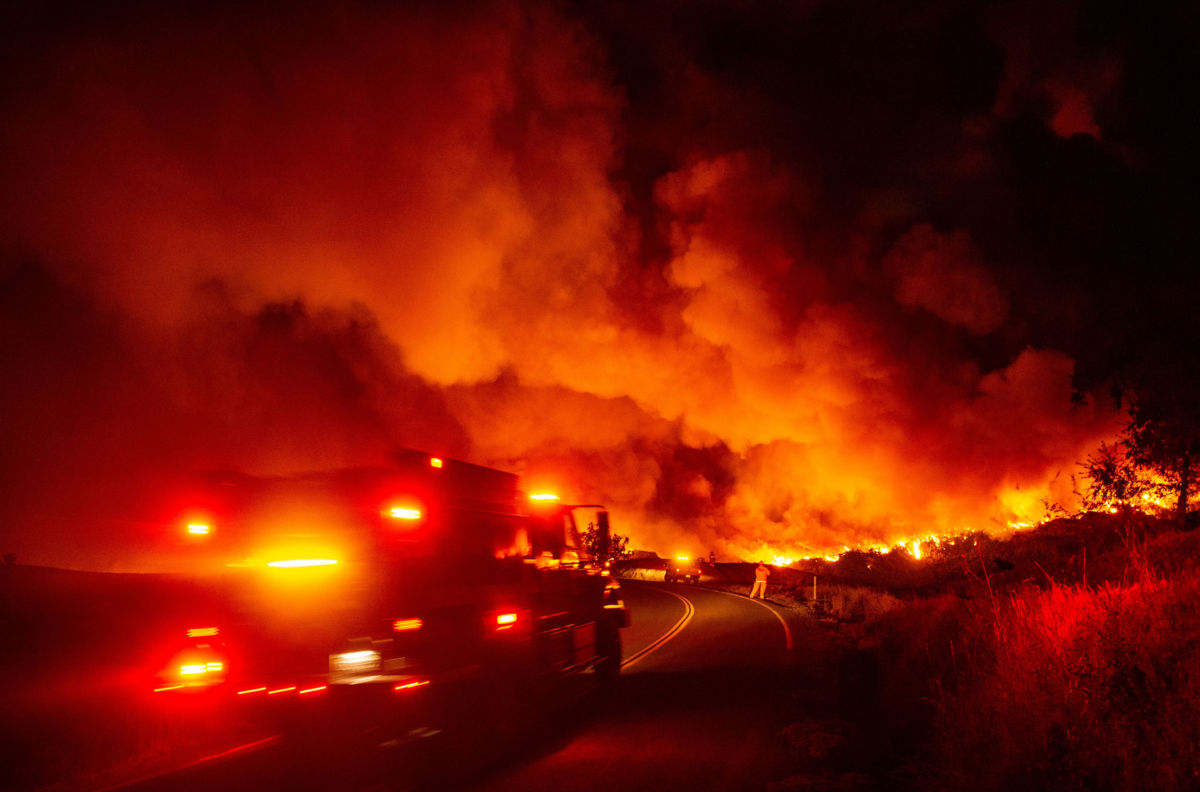Climate Crisis Stokes Flames in California, Putting Disabled People at Risk
At 10 am on Saturday morning, Cynthia Boaz, 49, packed up her dog, cat and seven chickens to head to her mom and stepdad’s home in Santa Rosa. Her and her husband’s home in Healdsburg, California, a small town in Sonoma County, was under threat of the Kincade Fire, which started 10 miles east of their home. Their home lost power shortly after she left.
Boaz had evacuated to her parents’ house once before, for nine days, when her home was between the Tubbs and Pocket fires of 2017. Then, she was able to stay at her parents’ home until her house was safe again. But this time around, her parents’ home wasn’t safe either. They soon got an evacuation notice for Santa Rosa, “so I evacuated with the animals (and also my parents) a second time in 10 hours,” Boaz told Truthout over email. They’ve been staying in a motel since Sunday night.
As the Kincade Fire raged across northern California — it’s burned over 75,000 acres so far — yet another fire broke out early Monday morning in western Los Angeles. The Getty and Kincade fires are two of 13 fires actively burning in a state where the electric utilities shut off power to almost 3 million customers to prevent wildfires.
Evacuation notices have been issued for hundreds of thousands of people, millions are without power, and the wildfire season continues to balloon in California. Felonious private utility PG&E, with a history of poor maintenance and ill-timed executive payouts, looms over the entire crisis.
Though firefighters don’t know the exact cause of the Kincade Fire yet, one of PG&E’s transmission towers malfunctioned near the origin of the fire, around the time that the fire started. It’s possible the company will be cleared of fault later, as it was following the 2017 Tubbs Fire, but it would come as no surprise if it weren’t; in May, the California Department of Forestry and Fire Protection found the utility responsible for sparking the 2018 Camp Fire, the most destructive wildfire in California’s history. The New York Times reports that, in fact, “five of the 10 most destructive fires in California since 2015 have been linked to PG&E’s electrical network.” Under financial pressure, the utility declared bankruptcy in January in order to protect itself against some of its losses over the numerous fires linked to its equipment.
The utility has neglected corroded towers and untrimmed foliage in favor of doling out millions of dollars in payouts to executives and shareholders. It’s “criminal negligence,” says Boaz.
“We have moved from the era of everyday wildfires to the era of fire storms, and PG&E has an ethical obligation to adjust accordingly,” she said. “But not at the expense of ratepayers.”
The utility has opened up resource centers in areas affected by power shutoffs that are open for 12 hours a day, where people can get water, charge their devices, and use portable restrooms. But many of these centers aren’t accessible to people with disabilities, some of whom depend on devices like CPAP ventilators to help them survive. As Stacey Milbern, a disability rights organizer in Oakland writes, “This week in the Bay Area, disabled people and elders without power are having difficulty breathing, moving, eating, and staying alive.” On Saturday, a local paper reported that a Santa Rosa man, dependent on an oxygen machine, died after the power to his home was shut down.
Matthew Cortland, a disabled writer and lawyer focused on public health issues, points out on Twitter that “With the rise in biologics, MANY more medications require refrigeration than 15 or even 10 years ago.” For people who rely on refrigeration to keep their medications safe, power shutoffs have put their lives on the line.
PG&E offers reduced rates for those who need to power medical equipment to survive, but when the power is out completely, they’re left to fend for themselves. Milbern says she called PG&E to ask about services for those who need power for medical services. “I was on hold for two hours and twenty minutes…. When I was finally connected, the representative confirmed there was nothing really in place” for those who needed medical assistance, she said.
To Boaz, the fact that fires are still sparking despite the power shutoffs is proof that PG&E has fallen far behind in fire mitigation. “PG&E painted themselves into that corner, and don’t deserve slack, because it was their actions and lack of ethical decision-making that created this situation in the first place.” She finds the fires to be both the fault of PG&E and unmitigated climate change.
Indeed, increasingly hot and arid seasons in California are exacerbating fire risk, and it’s only going to keep worsening; hotter days only put more strain on already dated infrastructure. To avoid future catastrophes like the current state of emergency in the state, California Gov. Gavin Newsom said that “things will have to radically change,” reports The Sacramento Bee. “This can’t be the new normal.”
Some progressive groups have suggested that PG&E become a publicly owned utility, in order to increase transparency and their responsibility to the public. Boaz says that this should be done “immediately.”
“At this point, the best thing PG&E can do to serve the community is to offer a huge outlay of goodwill to the people of Sonoma, Lake, and surrounding counties,” says Boaz, by deeply discounting their power rates. Boaz’s husband is an adviser for Sen. Mike McGuire of California, and her brother is the fire chief in Healdsburg, but even she isn’t getting any extra help. “Everyone is affected by these fires,” she said. For now, at least, Boaz says her house is still safe.




Geen opmerkingen:
Een reactie posten